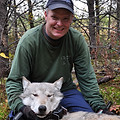Current Members
Our team is composed of Ontario Ministry of Natural Resources and Forestry staff and graduate students from Trent University.

Dr. Brent R. Patterson
Research Scientist and Adjunct Professor
I have been a research scientist with the Ontario Ministry of Natural Resource and Forestry’s (MNRF) Wildlife Research & Monitoring Section in Peterborough, Ontario, Canada since August 2001. I am also an adjunct professor at Trent University with the Environmental & Life Sciences Graduate Program, which offers instruction leading to either a MSc. or a Ph.D. degree. Prior to joining the Ontario MNRF, I worked for three years as a Regional Biologist for the Government of Nunavut, in the Canadian Arctic.
My primary research interests are in understanding the dynamics of mammalian predator-prey systems, and in determining the proximate and ultimate factors that cause changes in the distribution and abundance of animals. These interests fit well with my role as a research scientist with the MNRF where I work closely with graduate students, technicians, and other biologists/scientists to conduct and assimilate the research necessary to provide scientific support to policy makers within the MNRF. In collaboration with students and faculty of the Natural Resources DNA and Forensics Profiling Centre (NRDPFC) I have also been working on projects aimed at clarifying the taxonomy and interrelations of wolves, coyotes and their associated hybrids in Ontario and beyond.

Tyler Wheeldon
Large Mammal Biologist
I am currently a large mammal biologist with the Ministry of Natural Resources and Forestry’s (MNRF) Wildlife Research and Monitoring Section in Peterborough, Ontario. I have worked with the MNRF since December 2016, but had previously worked with the MNRF from October 2008 to December 2009. I obtained my Bachelor of Science degree from Carleton University in 2006, my Master of Science degree from Trent University in 2009, and my Ph.D. from Trent University in 2020. My current position with the MNRF involves field work, laboratory work, data analysis, and manuscript preparation related to wolf and coyote research in Ontario

Andrew Silver
Wildlife Research Technician
I have been a Wildlife Research Technician with the Ontario Ministry of Natural Resource and Forestry’s (MNRF) Wildlife Research & Monitoring Section in Peterborough, Ontario since 1991. I graduated from the University of Guelph with my Bachelor of Science degree.
My current job role has me involved in canid research across Ontario. I have also been part of polar bear, black bear, moose, deer, caribou, Canada and snow goose, rabies research and small mammal projects over my many years working in the wildlife section.
Graduate Students

Connor Thompson
Ph.D. Candidate
My main research focus is assessing how spatial variation in landscape characteristics, prey density, and harvest pressure influence the density and distribution of eastern wolves (Canis lycaon), eastern coyotes (Canis latrans var.), and associated hybrids in central Ontario. More specifically, I will look at canid territory size, diet, inter-pack competition, and dispersal movements with the purpose of assessing the potential for the expansion of eastern wolf populations beyond their core range in Algonquin Provincial Park.

Mariah Ward
M.Sc. Candidate
The main goal of my study is to assess the effects of harvesting bans put in place to protect Algonquin wolves in promoting natural social structures (family member-based packs) and population expansion. More specifically, I am aiming to assess whether family member-based wolf pack structures have been maintained in Algonquin Provincial Park following a shift from non-family member to family member-based packs after protection; and whether there has been a similar shift in and around Killarney Provincial Park, Kawartha Highlands Provincial Park and Queen Elizabeth II Wildlands Provincial Park where recent protection was put in place. Finally, I am assessing spatial and temporal factors that may influence non-family member-based pack formation in Algonquin wolves.